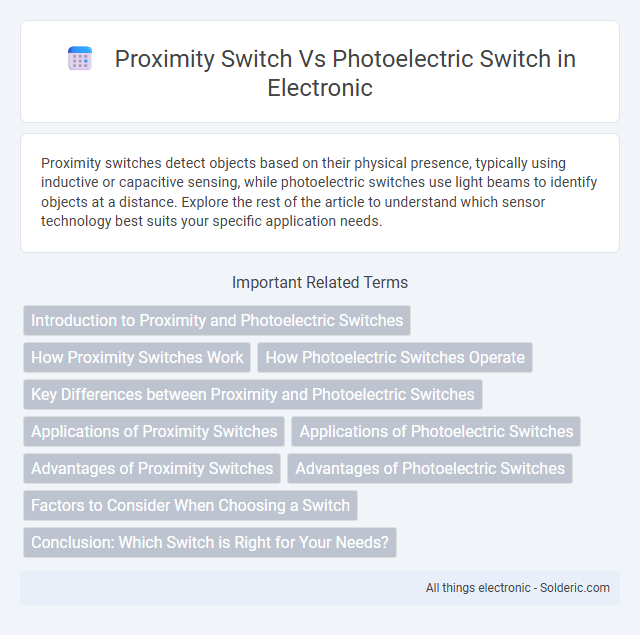Proximity switches detect objects based on their physical presence, typically using inductive or capacitive sensing, while photoelectric switches use light beams to identify objects at a distance. Explore the rest of the article to understand which sensor technology best suits your specific application needs.
Comparison Table
| Feature | Proximity Switch | Photoelectric Switch |
|---|---|---|
| Operating Principle | Detects objects via electromagnetic fields or inductive/capacitive sensing | Uses light beams to detect object presence or absence |
| Detection Range | Short (up to ~10 cm) | Long (up to several meters) |
| Target Material | Metal (inductive) or any material (capacitive) | Any object interrupting or reflecting light |
| Environmental Suitability | Resilient to dust, moisture, and dirt | Sensitivity affected by dust, dirt, ambient light |
| Response Time | Fast | Moderate to fast |
| Installation Complexity | Simple, flush or non-flush mount | Requires alignment of emitter and receiver |
| Applications | Position sensing, metal detection, proximity | Object detection, counting, presence sensing |
| Cost | Generally lower | Generally higher |
Introduction to Proximity and Photoelectric Switches
Proximity switches detect the presence of nearby objects without physical contact by using electromagnetic fields or capacitive sensing, making them ideal for metal object detection and harsh environments. Photoelectric switches rely on light beams or reflected light to identify objects at varying distances, providing high precision for transparent or reflective materials. Your choice between these sensors depends on the application's material type, detection distance, and environmental conditions.
How Proximity Switches Work
Proximity switches detect the presence of nearby objects without physical contact by generating an electromagnetic field or emitting ultrasonic waves, depending on the type. Inductive proximity switches sense metal objects through changes in an electromagnetic field, while capacitive switches detect changes in capacitance caused by any material. Your choice of proximity switch will depend on the specific application and target object type.
How Photoelectric Switches Operate
Photoelectric switches operate by emitting a light beam, usually infrared, from an emitter to a receiver, detecting objects when the beam is interrupted or reflected. This non-contact sensing allows for precise detection of transparent or opaque objects at various distances. Their ability to sense without physical contact makes them ideal for applications requiring high-speed or delicate object detection compared to proximity switches that rely on electromagnetic fields.
Key Differences between Proximity and Photoelectric Switches
Proximity switches operate by detecting the presence of metallic objects through electromagnetic fields, offering reliable contactless switching in harsh environments, whereas photoelectric switches utilize light beams to sense objects, enabling detection of both metallic and non-metallic materials with longer sensing distances. Proximity switches are ideal for applications requiring high durability and resistance to contaminants like dust and oil, while photoelectric switches excel in scenarios demanding precise object detection and varied sensing ranges. The choice between the two depends on factors such as material type, sensing distance, environmental conditions, and detection speed.
Applications of Proximity Switches
Proximity switches are widely used in industrial automation for object detection without physical contact, making them ideal for manufacturing lines to detect metal parts. They excel in harsh environments where dust, dirt, or moisture would impair photoelectric switches, such as conveyor systems, robotic arms, and safety locks. Your choice of proximity switches ensures reliable performance in applications requiring durability and precision sensing.
Applications of Photoelectric Switches
Photoelectric switches are widely used in industrial automation, packaging, and material handling systems due to their ability to detect objects without direct contact. These sensors excel in applications requiring precise distance measurement, presence detection, and counting of transparent or reflective objects. Your choice of a photoelectric switch ensures reliable operation in environments where non-contact sensing is critical for maintaining speed and accuracy.
Advantages of Proximity Switches
Proximity switches offer several advantages, including their ability to detect metal objects without physical contact, resulting in minimal wear and longer lifespan. These sensors provide high reliability and fast response times in harsh environments, such as those with dust, dirt, or moisture. You benefit from low maintenance requirements and robust performance in industrial automation applications compared to photoelectric switches.
Advantages of Photoelectric Switches
Photoelectric switches offer longer sensing ranges and can detect objects without physical contact, making them suitable for applications requiring non-intrusive detection. Their ability to sense transparent or small objects improves automation accuracy and efficiency in various industries. You benefit from reduced wear and maintenance costs compared to proximity switches due to their non-contact operation.
Factors to Consider When Choosing a Switch
When choosing between a proximity switch and a photoelectric switch, consider environmental conditions such as dust, dirt, and moisture, which affect sensor reliability and longevity. Proximity switches excel in harsh or metallic environments due to their resistance to contaminants, while photoelectric switches provide longer sensing distances and are ideal for detecting transparent or colored objects. Evaluate factors including target material, detection range, response time, and cost to select the optimal sensor for your application.
Conclusion: Which Switch is Right for Your Needs?
Proximity switches excel in detecting metal objects within short ranges using electromagnetic fields, making them ideal for industrial automation where durability and contactless sensing are crucial. Photoelectric switches offer versatile detection over longer distances and can identify a wide range of materials, perfect for applications requiring precise object presence confirmation or counting. Your choice depends on the operating environment and target object type, with proximity switches suited for rugged, metal-focused tasks and photoelectric sensors preferred for versatile, non-metal detection.
proximity switch vs photoelectric switch Infographic

 solderic.com
solderic.com